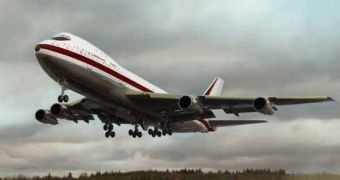Battles fought in the heights with powerful laser weapons are no longer the product of SF stories, as such a device has recently been tested with success. The Airborne Laser (ABL) was installed on a Boeing 747 airplane and carried aloft, where it fired shortly upon a ground target. Although the laser beam is invisible, it is still capable of doing a large amount of damage to its target, considering that the new weapon is part of the "megawatt class".
The ABL was developed by aerospace firms Boeing, Lockheed Martin and Northrop Grumman, and its first test consisted of shooting from a stationary aircraft towards a ground target a few meters below. The precise power of the device is still strictly classified, but the developers assure us that it's powerful enough in order to take down a large target several hundred kilometers away from the source. The companies involved see it as a response to rogue states' terrorist attacks, and equipping themselves with large range missiles.
But although the contractors, the Pentagon and the US Missile Defense Agency, label it as a defensive means, it is capable of performing dangerous actions. For instance, it can render satellites useless, either by destroying them via overheating their fuel tanks or by blinding their cameras, or even take down aircraft. "The ABL is not just for missile defense," shared Michael Rinn, Boeing vice president and ABL program director, cited by New Scientist. "We're optimised for ballistic missiles but there are modifications that could be made that would give us capabilities for countering aircraft, surface-to-air missiles and cruise missiles."
The entire laser device occupies almost the whole interior of the airplane. The craft would fly hundreds of kilometers away from a missile depot and would react upon detecting the heat signature of the missile at launch, instantly detonating it before it could even leave its launch site. The first real test on a disaffected missile will be performed next year. "We remain on track to complete a lethal demonstration in 2009," stated Rinn. "There's nothing like flaming missile wreckage to show the world the system is viable and that it works."
The whole project that has been going on for 12 years has gone way over the pre-estimated budget and has ultimately swallowed some $4.3 billion.

 14 DAY TRIAL //
14 DAY TRIAL //